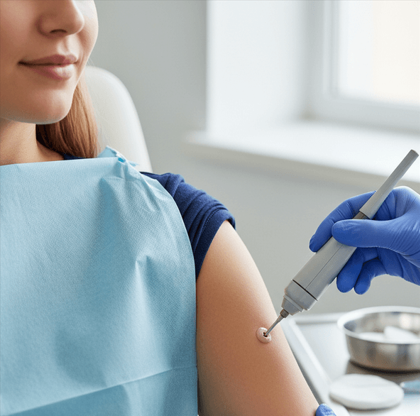Treatment Overview
Birth control implant insertion in Korea is a highly reliable, long-term, and reversible contraceptive option for women seeking convenient pregnancy prevention. The implant, a small flexible rod placed under the skin of the upper arm, releases a steady dose of hormones (usually etonogestrel) to prevent ovulation and thicken cervical mucus. Korean gynecologists are known for their precision and use of advanced ultrasound-guided insertion methods to ensure safety, accuracy, and minimal discomfort. The procedure typically takes less than 15 minutes and provides protection for up to 3–5 years.
Purpose & Benefits
The primary purpose of the birth control implant is to provide effective, long-term contraception without daily or monthly maintenance. Benefits include:
- Over 99% effectiveness in preventing pregnancy.
- Reversible method—fertility returns quickly after removal.
- Convenience—no need to remember pills or appointments.
- Light or absent menstrual periods for many users.
- Suitable for breastfeeding women.
- Minimally invasive procedure with quick recovery and low complication rate.
Ideal Candidates
This treatment is ideal for:
- Women seeking a long-term, low-maintenance birth control method.
- Those who cannot tolerate estrogen-based contraception (such as combined oral pills).
- Women who want a reversible yet highly effective contraceptive.
- Those with busy lifestyles or difficulty adhering to daily or monthly birth control routines.
- Postpartum women looking for safe, hormone-based contraception after childbirth.
Possible Risks & Complications
Although rare, some risks and side effects can occur:
- Temporary bruising, swelling, or pain at the insertion site.
- Irregular menstrual bleeding or spotting.
- Hormonal side effects like mood changes, headaches, or breast tenderness.
- Very rare infection or implant migration if improperly placed.
In Korea, such complications are minimized due to precise ultrasound-guided techniques and sterilized environments in certified women’s health clinics.
Surgical Techniques Used
Korean gynecologists use the most advanced ultrasound-guided insertion and micro-incision techniques for implant placement.
- Ultrasound Guidance ensures accurate positioning of the implant beneath the skin.
- Local Anesthesia is used for comfort and safety.
- Minimal-Incision Tools reduce scarring and healing time.
Removal is also performed with specialized micro-tools to minimize tissue trauma and prevent scarring.
Clinics in Korea often use FDA-approved implants like Nexplanon and Implanon NXT.
Recovery & Aftercare
Recovery from implant insertion is quick and easy:
- Most patients resume normal activities immediately after the procedure.
- Slight bruising or tenderness may last a few days.
- The insertion site should be kept clean and dry for 24–48 hours.
- Korean clinics provide personalized follow-up to ensure proper placement and patient satisfaction.
- If side effects occur, hormonal adjustment or implant repositioning can be easily managed.
Results & Longevity
The implant provides continuous protection for 3 to 5 years depending on the type used.
- Effectiveness remains consistent throughout its duration.
- Fertility typically returns within weeks after removal.
- Many Korean women report lighter and more regular periods after adjustment.
The long-term results are reliable, safe, and reversible, making it one of the most popular contraception options in Korea.
Treatment Process in Korea
Korea is renowned for its cutting-edge women’s health services and meticulous approach to contraceptive care. The treatment process generally includes:
- Comprehensive consultation with an English-speaking gynecologist who assesses health history and hormonal suitability.
- Ultrasound examination to identify the optimal insertion site.
- Painless local anesthesia followed by quick implant insertion using precision micro-tools.
- Post-procedure monitoring for a few minutes before discharge.
Korean clinics often combine the procedure with hormone balance assessments and fertility counseling to offer a personalized experience.
Advanced technologies like AI-assisted ultrasound mapping and microneedle anesthesia systems make the process smoother and virtually pain-free.
Why Korea is a top destination:
- World-class OB/GYN specialists trained in minimally invasive contraceptive techniques.
- High safety standards and sterilized environments.
- Multilingual support for international patients.
- Affordable pricing compared to Western countries.
- Integration of digital health tracking and follow-up via mobile apps.
Cost Range
The cost of birth control implant insertion in Korea varies depending on the clinic, implant brand, and additional tests:
- Average cost: ₩250,000 – ₩600,000 KRW (approx. USD $180 – $450).
- This usually includes consultation, implant device, insertion procedure, and post-care visit.
- Some premium clinics offer package deals that include removal or follow-up ultrasound checks.
Korea’s transparent pricing and high-quality medical care make it one of the best-value destinations for contraceptive treatments.
Popular Clinics for Birth Control Implant Insertion in Korea
- CHA Fertility Center Seoul Station – Known for advanced hormonal contraception and fertility care.
- Seoul Women’s Hospital – Offers comprehensive gynecologic and contraceptive services in English.
- Ewha Womans University Medical Center – Leading academic hospital specializing in women’s hormonal health.
- Maria Women’s Clinic – Popular for personalized birth control counseling and modern implant techniques.
- MizMedi Hospital – Offers one-stop reproductive health solutions, including implant insertion and fertility management.




